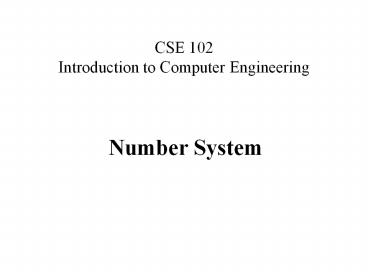CSE 102 Introduction to Computer Engineering PowerPoint PPT Presentation
Title: CSE 102 Introduction to Computer Engineering
1
CSE 102Introduction to Computer Engineering
- Number System
2
Number Systems
- Binary numbers (Base 2) 0,1
- Octal numbers (Base 8) 0,1,2,3,4,5,6,7
- Decimal numbers (Base 10) 0,1,2,3,4,5,6,7,8,9
- Hexadecimal numbers (Base 16) 0,1,2,3,4,5,6,7,8,
9,A,B,C,D,E,F
3
Decimal to Binary Conversion
- (102)10 (?)2
- (1100110)2
Divide by 2 Remainder
102 2
51 2 0
25 2 1
12 2 1
6 2 0
3 2 0
1 2 1
0 2 1
4
Decimal to Binary Conversion
- (0.125)10 (?)2
- (0.001)2
Multiply by 2 Integer part
0.125 2
0.25 2 0
0.5 2 0
1.0 2 1
5
Decimal to Binary Conversion
Multiply by 2 Integer part
0.4 2
0.8 2 0
1.6 2 1
1.2 2 1
0.4 2 0
0.8 2 0
1.6 2 1
1.2 2 1
0.4 2 0
- (0.4)10 (?)2
- (0.01100110)2
- (0.0110)2
6
Binary to Octal and Hexadecimal Conversion
- Octal (1100110)2 (?)8
- (001100110)2 (146)8
- 1 4 6
- Hexadecimal (1100110)2 (?)16
- (01100110)2 (66)16
- 6 6
7
Binary to Octal and Hexadecimal Conversion
- Octal (0.01100110)2 (?)8
- (0.011001100)2 (0.314)8
- 3 1 4
- Hexadecimal (0.01100110)2 (?)16
- (0.01100110)2 (66)16
- 6 6
8
Representation of Integers
- Signed-magnitude representation
- 2s complement representation
9
Signed-magnitude Representation
sign bit 0-positive 1-negative
integer
- Ex 10210
- - 10210
0 0 0 0 1 1 0 0 1 1 0
1 0 0 0 1 1 0 0 1 1 0
10
2s complement Representation
- To find 1s complement of a binary number change
1s to 0s and 0s to 1s - To find 2s complement of a number add 1 to its
1s complement - Ex (102)10 (0001100110)2
- 1s complement 1110011001
- 2s complement 1110011010
11
2s complement Representation
- Ex
- 10210
- -10210
0 0 0 1 1 0 0 1 1 0
1 1 1 0 0 1 1 0 1 0
PowerShow.com is a leading presentation sharing website. It has millions of presentations already uploaded and available with 1,000s more being uploaded by its users every day. Whatever your area of interest, here you’ll be able to find and view presentations you’ll love and possibly download. And, best of all, it is completely free and easy to use.
You might even have a presentation you’d like to share with others. If so, just upload it to PowerShow.com. We’ll convert it to an HTML5 slideshow that includes all the media types you’ve already added: audio, video, music, pictures, animations and transition effects. Then you can share it with your target audience as well as PowerShow.com’s millions of monthly visitors. And, again, it’s all free.
About the Developers
PowerShow.com is brought to you by CrystalGraphics, the award-winning developer and market-leading publisher of rich-media enhancement products for presentations. Our product offerings include millions of PowerPoint templates, diagrams, animated 3D characters and more.

